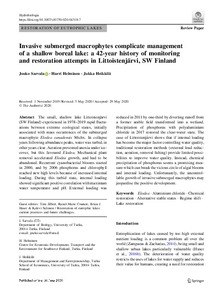Invasive submerged macrophytes complicate management of a shallow boreal lake: a 42-year history of monitoring and restoration attempts in Littoistenjärvi, SW Finland
Sarvala Jouko; Helminen Harri; Heikkilä Jukka
Invasive submerged macrophytes complicate management of a shallow boreal lake: a 42-year history of monitoring and restoration attempts in Littoistenjärvi, SW Finland
Sarvala Jouko
Helminen Harri
Heikkilä Jukka
SPRINGER
Julkaisun pysyvä osoite on:
https://urn.fi/URN:NBN:fi-fe2021042825667
https://urn.fi/URN:NBN:fi-fe2021042825667
Tiivistelmä
The small, shallow lake Littoistenjärvi (SW Finland) experienced in 1978-2019 rapid fluctuations between extreme ecological states, initially associated with mass occurrences of the submerged macrophyte Elodea canadensis Michx. In collapse years following abundance peaks, water was turbid, in other years clear. Aeration prevented anoxia under ice-cover, but this favoured Elodea. Mechanical plant removal accelerated Elodea growth, and had to be abandoned. Recurrent cyanobacterial blooms started in 2000, and by 2006 phosphorus and chlorophyll reached new high levels because of increased internal loading. During this turbid state, internal loading showed significant positive correlation with maximum water temperature and pH. External loading was reduced in 2011 by one-third by diverting runoff from a former arable field transformed into a wetland. Precipitation of phosphorus with polyaluminium chloride in 2017 restored the clear-water state. The case of Littoistenjärvi shows that if internal loading has become the major factor controlling water quality, traditional restoration methods (external load reduction, aeration, removal fishing) provide limited possibilities to improve water quality. Instead, chemical precipitation of phosphorus seems a promising measure which can break the vicious circle of algal blooms and internal loading. Unfortunately, the uncontrollable growth of invasive submerged macrophytes may jeopardise the positive development.
Kokoelmat
- Rinnakkaistallenteet [27094]
